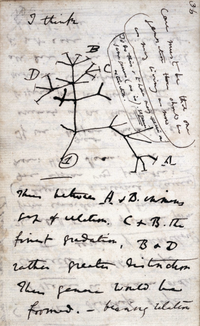
Photo from wikipedia
The geographical distribution of many crop species spans far beyond their centers of origin and the native range of their wild ancestors. Maize is exemplary of this adaptability, which has… Click to show full abstract
The geographical distribution of many crop species spans far beyond their centers of origin and the native range of their wild ancestors. Maize is exemplary of this adaptability, which has contributed to its agricultural... Understanding the evolutionary capacity of populations to adapt to novel environments is one of the major pursuits in genetics. Moreover, for plant breeding, maladaptation is the foremost barrier to capitalizing on intraspecific variation in order to develop new breeds for future climate scenarios in agriculture. Using a unique study design, we simultaneously dissected the population and quantitative genomic basis of short-term evolution in a tropical landrace of maize that was translocated to a temperate environment and phenotypically selected for adaptation in flowering time phenology. Underlying 10 generations of directional selection, which resulted in a 26-day mean decrease in female-flowering time, 60% of the heritable variation mapped to 14% of the genome, where, overall, alleles shifted in frequency beyond the boundaries of genetic drift in the expected direction given their flowering time effects. However, clustering these non-neutral alleles based on their profiles of frequency change revealed transient shifts underpinning a transition in genotype-phenotype relationships across generations. This was distinguished by initial reductions in the frequencies of few relatively large positive effect alleles and subsequent enrichment of many rare negative effect alleles, some of which appear to represent allelic series. With these genomic shifts, the population reached an adapted state while retaining 99% of the standing molecular marker variation in the founding population. Robust selection and association mapping tests highlighted several key genes driving the phenotypic response to selection. Our results reveal the evolutionary dynamics of a finite polygenic architecture conditioning a capacity for rapid environmental adaptation in maize.
Journal Title: Genetics
Year Published: 2019
Link to full text (if available)
Share on Social Media: Sign Up to like & get
recommendations!